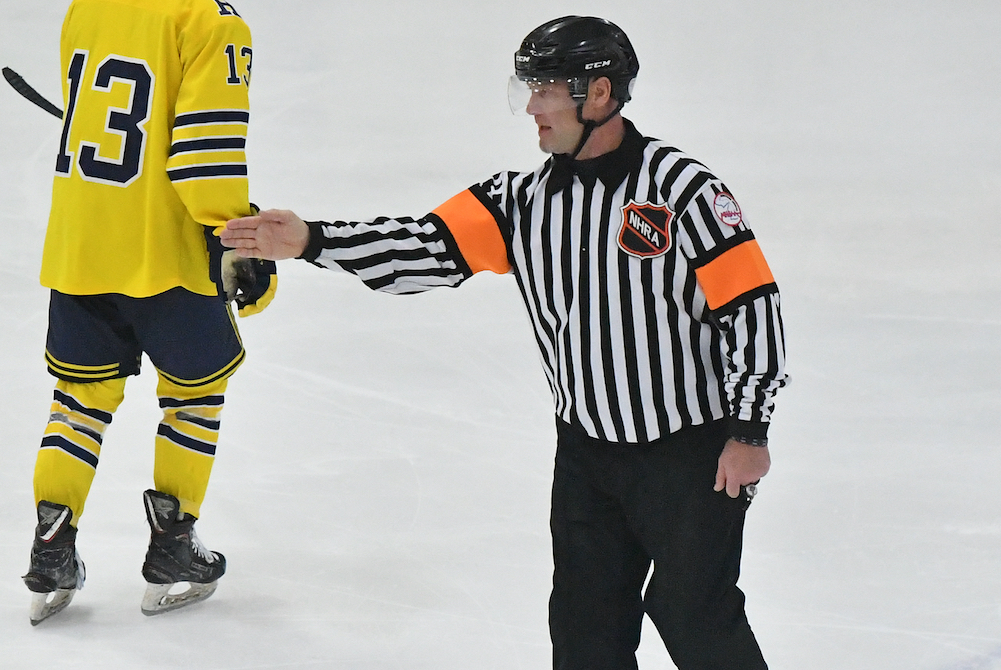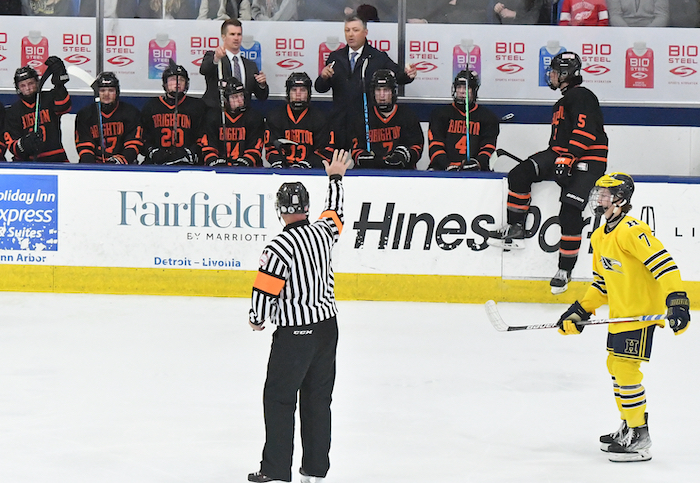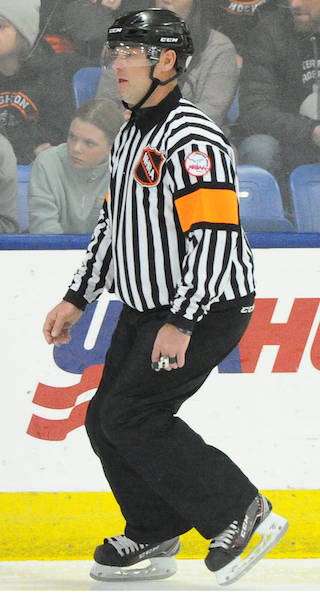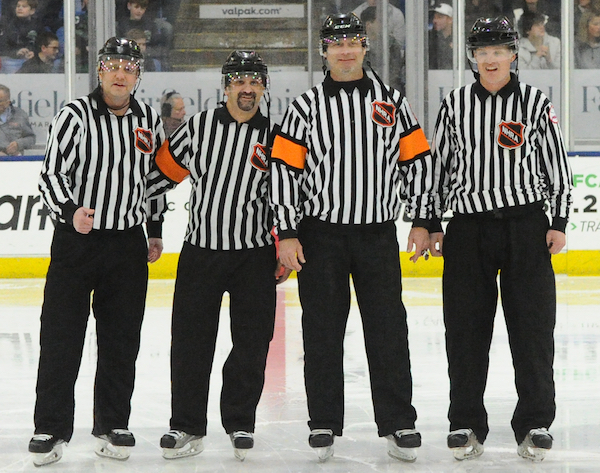
Heritage Follows 1st Final with Fast Start
By
Paul Costanzo
Special for MHSAA.com
January 15, 2019
Members of the Saginaw Heritage hockey team said they didn’t need extra motivation this offseason.
 With all but three players returning from a team that had made the program’s first MHSAA championship game, the Hawks knew if they put in the time, another special season could be in front of them.
With all but three players returning from a team that had made the program’s first MHSAA championship game, the Hawks knew if they put in the time, another special season could be in front of them.
But the schedule makers gave them something to look forward to anyway – a season-opening rematch with Brighton, the team that had defeated them in the Division 1 title game eight months prior.
“There was for sure a little revenge in the back of our minds coming into that game,” Heritage junior forward Brady Rappuhn said. “I think the Finals last year was a stepping stone for us. Even though we didn’t win, just the experience was good for us.”
Heritage won the rematch 7-1 on Nov. 17 and hasn’t looked back, starting the season 11-0 and winning every game by four goals or more. It’s a stunning beginning that includes wins against six ranked teams, including two (Brighton and Salem) top-five teams in Division 1. That dominance has elevated Heritage to No. 2 in Michigan Hockey Hub’s Division 1 rankings, and No. 3 in its Super 10 pooling the best from all three divisions.
And nobody on the team seems surprised by it.
“We only lost three players from last year’s team, and we had a couple guys come in that were real good hockey players,” Heritage coach JJ Bamberger said. “Just the returning core of players we had, we were expecting to have a pretty good run. We talked about at the beginning of the year – last year, we fell short by one game, but we didn’t want to talk about getting back to that point. We just want to work on getting better every time we’re on the ice.”
Several factors have led to Heritage’s amazing start, but the one that could benefit the Hawks most later in the season is their incredible depth. Seven players are averaging at least a point per game, led by Rappuhn who has 14 goals and 15 assists thus far. Two other players – Parker Severson and Edison Symons – have scored 10 goals. Sixteen players have scored at least one goal, and 19 have registered at least one point.
That depth extends to the crease, where starting goalie Jack Jesko has a 1.32 goals-against average and .931 save percentage over eight games. Backup Jacob Winters has played three games and allowed just one goal on 42 shots.
The most remarkable statistics, however, are in the period breakdowns. The Hawks are outscoring opponents 19-5 in the first period, 25-5 in the second and 31-1 in the third.
“That first period a team will hang with us, but we just keep going,” said Bamberger, who noted that each player on his team having a GPA of 3.0 or higher is actually the most remarkable statistic. “I’ve been coaching for 17 years, and it’s the deepest team we’ve had. Sometimes I’ve had top guys who were better, but I’ve never been able to have that many guys coming at you nonstop. If a team plays two lines against us, it’s going to be very difficult to keep up with our speed. There’s no weakness.”
 The Hawks’ depth also creates a mental edge for the players.
The Hawks’ depth also creates a mental edge for the players.
“We can roll anybody out there, and I think any of our lines can play against anybody,” Rappuhn said. “We have confidence in everybody on our team. We have a trust in our teammates and what our coaches tell us, and that allows us to be a better team.”
It also keeps them sharp.
“If you have a bad game, you know another guy is coming for your spot,” senior defenseman and captain Joe Watson said. “It pushes us forward and gives us a little bit of competitiveness to keep our spots.”
Heritage’s rise didn’t happen overnight. The building blocks were laid nearly a decade ago through the Saginaw Jr. Spirit program, which gives youth players in the area a chance to play together against top-level competition.
“The goal was to have the best players from Saginaw, Midland and Bay City come together,” said Bamberger, who is the director of the Jr. Spirit, and added teams such as Midland Dow and Davison are also seeing the benefits of the program. “It’s one program that was kind of set up for the whole Tri-City Area.”
Much of Heritage’s nucleus played for the Jr. Spirit, many of the current Hawks winning one – or in some cases, two – state titles.
“They won back-to-back state championships, so they knew how to win,” said Watson, one of a handful of Heritage players who did not play for the Jr. Spirit. “That just kind of helped us out.”
With all this positive momentum, there could be a temptation to look ahead to another MHSAA Finals appearance. But the Hawks claim they instead are sticking to Bamberger’s advice of focusing on day-to-day improvement.
“I think our coaches have really put it in our minds that we can’t look ahead, because any team can beat us any night,” Rappuhn said. “We’re a really good team, but there are also a lot of good teams that we’re playing, so if we don’t come ready to play, any team can beat us. We try to worry about that game, and that period, and that shift. We don’t try to look ahead.”
Even when asked to reflect on what they’ve accomplished, and how it would feel to win the school’s first MHSAA title in hockey, the players stayed fairly grounded.
“It’s just been a really good experience to go through,” Watson said. “I strongly believe everyone on the team is not going to take it for granted if we do get back there. It would be pretty good to get there again, and hopefully win it.”
 Paul Costanzo served as a sportswriter at The Port Huron Times Herald from 2006-15, including three years as lead sportswriter, and prior to that as sports editor at the Hillsdale Daily News from 2005-06. He can be reached at [email protected] with story ideas for Genesee, Lapeer, St. Clair, Sanilac, Huron, Tuscola, Saginaw, Bay, Arenac, Midland and Gladwin counties.
Paul Costanzo served as a sportswriter at The Port Huron Times Herald from 2006-15, including three years as lead sportswriter, and prior to that as sports editor at the Hillsdale Daily News from 2005-06. He can be reached at [email protected] with story ideas for Genesee, Lapeer, St. Clair, Sanilac, Huron, Tuscola, Saginaw, Bay, Arenac, Midland and Gladwin counties.
PHOTOS: (Top) Saginaw Heritage players, including junior Connor Krauseneck (12), celebrate one of their many highlights this season. (Middle) Hawks senior Dane Senkowski (22) pushes the puck up ice as a Grandville player trails him. (Photos by Amy Best.)

Retired NHL-er Back on Ice to Answer Call - By Making Them
By
Rob Kaminski
MHSAA benchmarks editor
March 16, 2023
The most accomplished skater on the ice during Friday’s triple-overtime MHSAA Division 1 Semifinal hockey thriller between Hartland and Brighton was not wearing the school colors of either team.
In front of a packed house at Plymouth’s USA Hockey Arena, referee Bryan Smolinski was in stripes, just like the rest of his officiating crew.
In his former life, he pulled on plenty of sweaters before lacing up the skates. That happens when one logs more than 1,000 games, tallies nearly 300 goals (274) and close to 400 assists (377) with eight teams spanning a 15-year playing career in the National Hockey League.
So, how did the 52-year-old former star player find himself on the ice last weekend as one of the referees for the pinnacle weekend of this high school season? Good question, even for the man known as “Smoke” during his playing days.
“I was working in youth development programs a few years back and reached out to some Michigan guys I had connections with about other ways to help the game,” Smolinski said. “I called Kevin May just to chat and asked, ‘Hey, how’s your reffing going?’ He said, ‘You know, we’re down a little bit,’ then said, ‘Why don’t you do it?’ I said, ‘Not a chance,’” Smolinski laughed.
Never Say Never
May persisted, imploring his friend to skate with him during a Fall league at Cranbrook in Bloomfield Hills. After eight weeks, once a week, Smolinski had a revelation.
“I’m like, ‘I’m kind of diggin’ this,’” Smolinski said “So, I did all the testing, and the educational part of it, and I really enjoyed it. I got with Danny (DiCristofaro) and his group, and he put me in as much as he could, and I really started to get my feet wet.”
 DiCristofaro is the assigner and referee-in-chief for the MHSAA’s Northeast Hockey Referees Association, and he has seen Smolinski’s growth first-hand.
DiCristofaro is the assigner and referee-in-chief for the MHSAA’s Northeast Hockey Referees Association, and he has seen Smolinski’s growth first-hand.
“Obviously he’s got great instincts and a feel for the game, along with a wealth of experience, all of which has allowed him to climb the ladder quickly,” said DiCristofaro. “It’s been a joy to watch his growth as an official.”
Fast forward to last Friday, and there were Smolinski and May sharing duties as referees during the MHSAA Semifinal with linesmen Michael Andrews and Thomas Robbins.
In between, there has been a learning curve that still continues, but the jump to officiating was not quite as daunting as his introduction to the NHL.
“I was scared to death. My first game was against Mario Lemieux. I’m in the old Boston Garden and now I’m playing against these guys and it’s their job, and they’re out there trying to make a living,” Smolinski recalled.
The emotions were not running nearly as frenzied for his first game as an MHSAA official, obviously, yet respect came in a different form.
“I couldn’t pick the puck up, I was breathing heavily; it was Kevin and me doing a two-man game in Brighton,” Smolinski recalled. “There were a few high-end kids playing, and I’m thinking, ‘I’m dying here.’ You know, there’s no training for that first time.”
What that experience did, however, was revitalize Smolinski in a new way. His playing career is well documented, not only in the NHL, but around Michigan. He enjoyed an honor-laden career at Michigan State University from 1989-93 before joining the Boston Bruins (who had drafted him three years earlier) at the end of the ’93 NHL campaign. Even after his final season, with Montreal in 2007-08, he stayed in the game via men’s leagues, or coaching his son, Max.
Smolinski and his wife, Julie, have three daughters: Ashtyn (22), Jojo (16) and Rylen (12), along with Max, whom dad coached for seven years including during a national championship run with a Little Caesars U15 team in 2019. Max, 19, is now playing collegiately at Rensselaer Polytechnic Institute.
So, for Smolinski, officiating offers a new chapter.
“Reffing brought back ... I wouldn’t say love of the game, because that’s always been there; it’s a different side of enjoying the game now. I have no horse in the race, my son’s off to college, my daughters are doing their thing; I wanted to find something new in the game,” Smolinski said. “I’ve coached, and I don’t want to do that. I found this, and I’ve stuck with it.”
Old College Ties
One of the great benefits of athletics at any level are the friendships made. For two kids who met in their first years on the MSU campus and forged a bond that lasts to this day, it’s amazing how their careers reached the pinnacle and have now come full circle.
Wes McCauley, an MSU teammate, is one of Smolinski’s best friends. After numerous years in the minor leagues, McCauley, like his friend, made it to the NHL. But McCauley made it as an official, working his first NHL game in 2003, when Smolinski was nearing the end of his playing career.
 Their games lined up on just a few occasions in the NHL, and the two lobbied hard to have McCauley work Smolinski’s 1,000th career game in his final season with the Canadiens in 2007-08. The request, sadly, was denied by the league.
Their games lined up on just a few occasions in the NHL, and the two lobbied hard to have McCauley work Smolinski’s 1,000th career game in his final season with the Canadiens in 2007-08. The request, sadly, was denied by the league.
On the rare occasions when the friends did share the same ice, less than a handful by Smolinski’s count, it was McCauley who was forced to rebuff any attempts at fraternization. It’s just part of an official’s edict.
“For both of us, it was amazing; it was just great,” Smolinski said. “I’d say, ‘Hey man what’s up?’ and he says, ‘Can’t talk.’ I’m like, ‘What do you mean, we talk all the time.’ Again, he’s like, ‘Can’t talk, get away from me.’ You know, it was just business.”
McCauley then reached the 1,000-game plateau himself in 2018 and is still going strong as a regular selection for playoff duties with nine Stanley Cup Finals assignments, including last year.
So, it should have been natural for Smolinski to go to his old friend immediately for officiating pointers once he joined the ranks, right? Well, maybe not immediately.
“I talk to Wes all the time, but I actually hid it from him right out of the gate because I didn’t want to take his razzing. Eventually it got out, and he was loving it. He started sending me whistles and visors and pants,” Smolinski said, grinning. “And none of it fit, you know, because I’m older and fatter, and he’s so damn skinny. So, I still had to go out and get all new gear.”
Both Sides Now
Having been to the top of his profession, now moving to the other side of that same mountain that his friend McCauley scaled, the respect has grown for those blowing the whistle.
“The preparation for officiating is much more mental,” Smolinski said. “Way more rules oriented. You’re always trying to get away with things that you can as a player; now you have to police that.”
Smolinski has a distinct advantage.
“I know everything they’re trying to do because I’ve done it. I know where you’re going with the puck, I know what kind of breakout you’re trying to do,” Smolinski said. “I have all the instincts, now I just try to stay out of the way and not ruin their game. The most fun is watching the game develop and the ups and downs. For me to be out there and enjoy it with them, that’s the fun part.”
 Those who have played hockey at any level have a built-in advantage should they consider the officiating avocation: the ability to skate. Unlike officiating in any other sport, skating is a prerequisite. This makes the pool limited, and almost solely composed of former players. Smolinski offers this advice.
Those who have played hockey at any level have a built-in advantage should they consider the officiating avocation: the ability to skate. Unlike officiating in any other sport, skating is a prerequisite. This makes the pool limited, and almost solely composed of former players. Smolinski offers this advice.
“I prefer sticking with high school because I think there’s more decorum, more administrative structure. Kids are playing for their schools, there’s loyalty there,” said Smolinski. “And there is more accountability. People need report to athletic directors and supervisors. Other levels can be more loosely governed, or a bit more maverick in nature. Moms and dads get involved more, coaches maybe know a little less,” said Smolinski.
He has, in fact, worked a handful of non-school games, and there’s a stark difference.
“I wanted to see what was going on, and I see it first-hand,” Smolinski said. “There are some crazy people and parents out there, and these guys are getting absolutely tortured. I’ve been tortured. There has to be a level of respect for what officials do. I think schools can rein that in a little more. All the guys I’ve met give up a lot of time and work hard because they love to do it and love the game.”
All sports need an assist from school administration and from those who once played the games to keep the officials recruitment moving in the right direction. People like Smolinski can help.
“He clearly doesn’t need to do this, and that’s what makes it so fantastic,” DiCristofaro said. “We need more people who have played – at any level – to do what he’s done and stay in the game as officials.”
Smolinski continues to promote the game in other ways as well. Currently, he is involved in the NHL’s Learn To Play initiative, which aims to inspire youth and welcome more families into the hockey community.
“We work hand-in-hand with the NHL Players Association for player development and industry growth,” Smolinski said. “Ages 5 to 9 are introduced to hockey, get head-to-toe gear and instruction, and meet some former players.”
The idea is to have fun first, which can translate into years and maybe even a lifetime in the sport. It’s a lifetime that has given Smolinski so much and continues to do so as he watches it unfold for others from his new vantage point.
PHOTOS (Top) MHSAA official Bryan Smolinski signals during Friday's Division 1 Semifinal between Brighton and Hartland. (2) Smolinski, a retired NHL standout, communicates with the Bulldogs' bench. (3) Smolinski keeps watch during game play. (4) Smolinski, third from left, with his crew: Michael Andrews, Kevin May and Thomas Robbins.

